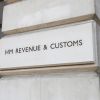In this article I wrote in 2022, I explained the purpose of yellow boxes, the importance of good design to ensure they are no bigger than necessary and the lack of clarity in the Department for Transport’s guidance on this key issue. In this report I review the size of 100 of the top enforced boxes (in terms of ticket numbers) in London and Cardiff.
A recap: The purpose of a yellow box
The purpose of a yellow box is to prevent the obstruction of cross or through movements that would otherwise have a clear passage. A typical scenario is shown below:
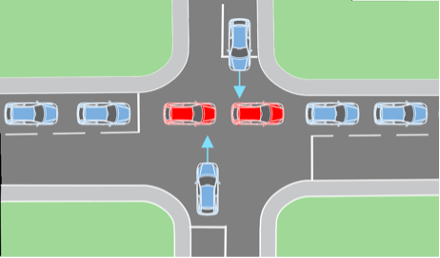
Of course there are many different junction shapes. The most accurate way to determine the necessary box size is to use what we call vehicle ‘tracking’ or ‘swept path analysis’ to identify the cross conflict areas and design the box to cover that area. For example, a typical T-junction is shown below. A box painted across the whole of this junction – as marked in red – would be bigger than necessary. Only the area in yellow is preventing cross-traffic movements:
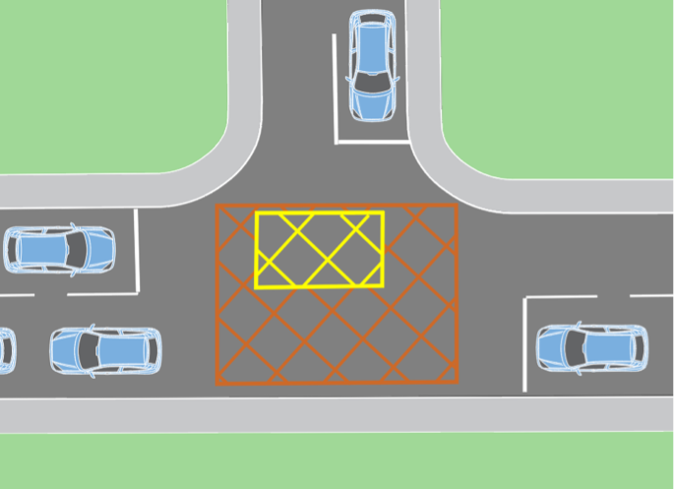
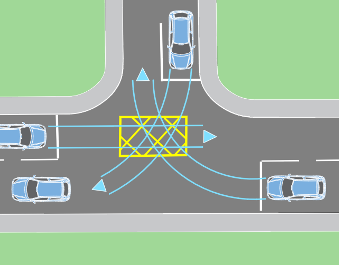
The image below shows an example of a box in Birmingham which is too big. Taking into account the permitted lane movements, only the yellow area prevents the obstruction of cross movements and is thus justified:

Another example can be seen in the video and image below. The purpose of the box is to help buses turn into the side road. The video shows that the bus is easily able to turn in, despite the fact a vehicle has stopped on the box - proof that the box is bigger than it needs to be.
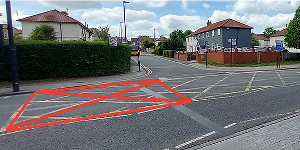
The parts of boxes which do not cover cross movements serve no traffic purpose. Further, as drivers are not causing any obstruction to traffic flow, there is no traffic justification to issue fines to drivers if they stop on those areas. As the penalty relates to any part of a vehicle in a box, even a bumper overhanging could result in a fine of up £130. It is therefore vitally important that every metre of a box is justified.
The review criteria
While there are a plethora of issues associated with yellow boxes, which are all the more relevant now councils across the country have the powers to enforce them, in this study I specifically review the size of 100 of the top yellow boxes (in terms of penalties given to drivers) currently being enforced in London and Cardiff. These two cities were the first in the UK to be given enforcement powers. The boxes have been ranked based on publicly available data related to the number of tickets (penalties) issued to drivers in the pre-pandemic year 2019.
Not all authorities’ data is readily available and ticket numbers can vary year on year due to factors such as roadworks. Therefore the list does is not necessarily a definitive one of the highest ticketed boxes. However, for the purpose of this review it gives an excellent sample to assess.
Analysis
Using the criteria outlined above for determining the ideal size, I marked up the parts of each box which are unnecessary. The surface area of each box and the unnecessary areas have been worked out using Google Maps. This is an approximation and may not entirely accurate, however it gives a good indication of order of magnitude.
The results of the study show that:
- 98 of the 100 boxes are bigger than they need to be
- The boxes are on average 50% bigger than they need to be
- 53 of the boxes are not under signal control and could easily be converted to ‘keep clear’ markings to serve the same purpose
Full details of all yellow boxes analysed and the corresponding results can be found in the table below. Columns can be sorted:
As well as serving no traffic purpose, boxes that are bigger than they need to be create a number of issues for drivers. In accordance with the Highway Code, drivers have a duty to only proceed through a yellow box when the exit is clear. This means they have to judge if the gap on the exit side of the box is big enough to receive their vehicle. The bigger the box, the more difficult this task is.
In the example image below of an enforced box in the borough of Waltham Forest in London, the box extends beyond the junction such that it is difficult for drivers to see exactly where it ends. The red line shows where it should finish. Had it been designed correctly and ended at the red line, the driver would have been able to see more clearly and it would be in line with his or her expectations. Motorists know they have a duty not to block a junction, and clearly if they do stop in the middle of a junction this is wrong. However, they shouldn’t have to play this guessing game of trying to figure out exactly how far extra the authority has decided to paint their box. In the words of one adjudicator “Motorists are entitled to make the assumption that the yellow box will finish once the junction is cleared” (2170582946 Martin Forshaw v LB of Richmond Upon Thames, York St / Arragon Rd)
Bearing in mind that even the back bumper of a vehicle overhanging a box can be enough to get a ticket, many people end up getting fined – not for deliberately blocking a junction, but for simply being unable to see where a box ends and accurately judge distance from an acute angle.
Below: drivers’ view of an unnecessarily large box – can a vehicle fit in the gap beyond the box?
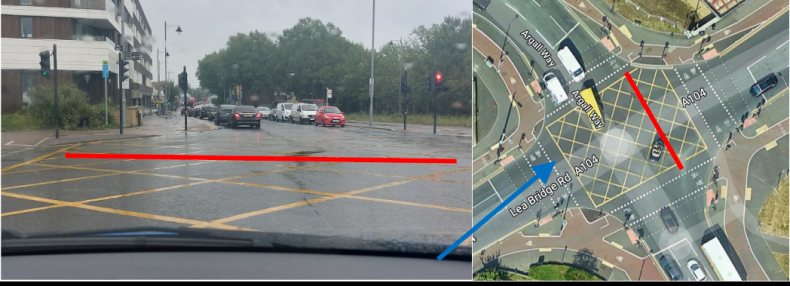
As each driver must stop and wait for the vehicle in front to cross the box before they proceed, longer boxes mean the time taken to make this judgement increases. This means traffic flow can actually be reduced – meaning the yellow box is serving the exact opposite for which it is intended.
Compliant or non-compliant?
According to the regulations, boxes have to be at the junction of two or more roads (or outside a police, fire or ambulance station). However, the exact boundary of where a junction starts/ends is not defined. Therefore it becomes somewhat subjective as to what is permitted in terms of size. We can use previous adjudicator decisions to guide us, and one adjudicator stated that “extending the box junction by a car length or more beyond the actual junction is neither compliant nor substantially compliant with requirement”. (2170285940 Stephen Thurston v LB of Richmond Upon Thames, York St / Arragon Rd)
In my judgement, using the following criteria to define non-compliant boxes, 22 of the 100 boxes could potentially be classified as or “non-compliant” with the regulations:
- Extend beyond a junction by at least a car length
- Are in a non-permitted location
- Cover the far side of a T junction (ruled in several recent adjudicator cases to be non-compliant
As noted above, this is not definitive and it would be up to individual adjudicators to make a decision on.
However, whether or not the boxes are legal or illegal is slightly beside the point. For example, many people will be surprised to know there is no legal minimum lane width. As professional engineers we don’t design lanes two metres wide just because it is ‘legal’ and we can get away with it. The same should be true for yellow boxes. They should be designed first and foremost to meet traffic objectives, not to push the boundaries of the law. However given that many authorities do push the boundaries, it is vital that the Department of Transport revises the statutory guidance to make it clear what is acceptable.
Why are so many yellow boxes bigger than they need to be?
- Government guidance: The official government guidance to authorities on yellow boxes is contained in Chapter 5 of the Traffic Signs Manual. Fundamentally, it does not explain what the purpose of a yellow box is and how to design them to ensure they are the correct size.
- Previous regulations: The previous version of the regulations which govern box placement and size (prior to 2016) required boxes to touch the kerbs. This meant boxes had to be designed bigger than they need to be in order to comply with Department for Transport regulations. Many of these legacy boxes remain on our roads.
- Engineers'/designers' lack of understanding: I train engineers on how to design boxes for a living and the lack of understanding in the industry of the purpose of yellow boxes the rules is profound. Many believe, for example that there is generic exemption for right tuners (not true) and do not consider the fact that left turners are not exempt. This, combined with a lack of care and attention, results in poor design. In the past if a box was too big it wasn’t really a big issue and that probably resulted in a bit of a laissez faire attitude to design. However the design becomes very important when they are enforced. The public should rightly be able to expect that those designing yellow boxes know what they are doing.
- Revenue: The bigger a box, the more revenue it generates it fines. This may go some way to explaining why some authorities are reluctant to address their oversized boxes. The lack of clear, definitive guidance from the Department of Transport also gives them a convenient cover when challenged. Although there are practical challenges to changing boxes, as a minimum there is no reason why enforcement cannot target just the useful, relevant area of a box instead of all of it.
Conclusion
The enforcement of parts of yellow boxes that are too big and serve no traffic purpose is a misuse of powers that were originally well intended to help reduce congestion. This is a not a problem which affects one specific authority, it is an industry-wide issue resulting in thousands of pointless tickets being issued to motorists. The expansion of enforcement powers outside London by the Government, without clarifying specific design requirements, has exacerbated the issue. For this reason, we need government regulations or statutory guidance to be updated to more precisely define how boxes should be designed and stop motorists from being exploited.



